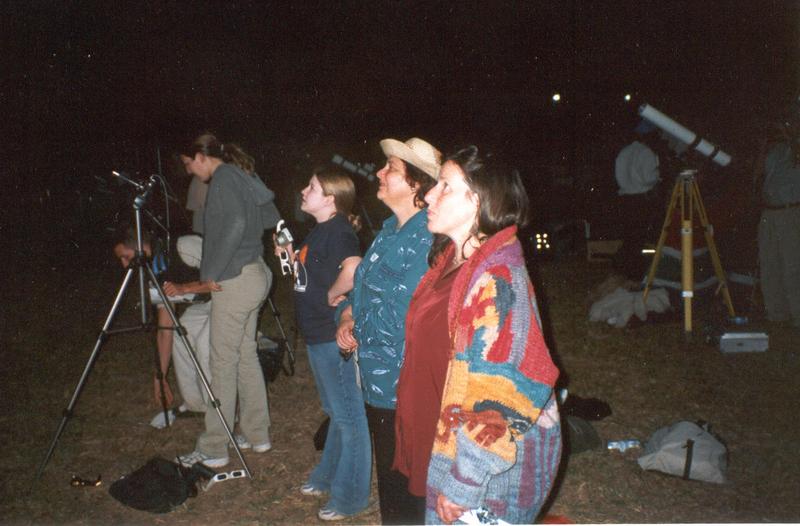
| HartRAO Home | Eclipse Home | Eclipse Next | Eclipse Previous |

The picture above shows people watching the totally eclipsed Sun in Lusaka on 2001 June. The person on the left is using a 35mm SLR camera with a 200mm telephoto lens to photograph the eclipse. The people in the centre are enjoying the naked eye spectacle of the eclipsed Sun. They do not need eclipse viewers now - the light level is a bit brighter than a full Moon. On the right is a telescope that is being used to look at the eclipse. Note that best practise is NOT to use a flash during totality!
If you are going to be in the path of totality, plan carefully what you will do during the maximum of 86 seconds that totality will last on the centreline in South Africa. Here are some ideas of what to do or look for:
Firstly, don't forget to enjoy the spectacle!
Make your own eclipse movie - set up a video camera on a tripod east of you and aimed at you to record what happens. Put a white sheet on the ground in front of it and in its field of view (for shadow bands - see below). Start recording about 15 minutes before totality.
Use a GPS receiver to get accurate time. Count down to the predicted start of totality at your location. Time will seem to 'speed up' as totality approaches.
Look for changes in the colour of the daylight before and after totality.
Put out a thermometer (in shade) to measure the change in air temperature during the eclipse.
Before totality "pinhole project" your logo (see later webpage)
Watch for "crescent suns" - natural pinhole projection - where sunlight shines through tree leaves, before totality (see later webpage).
Before totality project an image of the sun onto white card with binoculars (see later webpage).
Spread a white sheet on the ground and look for "shadow bands" - faint moving zebra stripes - just before, during and after totality. DO NOT use a flash if photographing them.
During totality look at the Sun's corona (million degree atmosphere), as shown in the animation of the total eclipse. During totality only, use the naked eye or binoculars.
During totality look for flares at the edge of the Sun. These may appear pink or red.
Bright planets and stars may become visible during totality. A chart of their positions is shown on a later webpage.
Look for the "Baily's Beads" and the "Diamond Ring" at the start of totality or as the first part of the Sun emerges after totality.
Watch the behaviour of animals and birds during the eclipse. In Kruger Park, watch for hunting predators and hippos leaving the rivers.
Watch the behaviour of the people around you!
Alternatively, use a camera to record what people do. Best practise is - don't use flash! Especially near people photographing the eclipse. And especially not in their faces and cameras. Best practise is to use natural light, which is rather brighter than the light from a full moon. This will typically show the eclipse watchers silhouetted against the "sunset" around the horizon.
Photograph the eclipsed sun - more detailed advice on photography is given later.
Viewing a solar eclipse can cause eye damage. HartRAO disclaims any loss or injury howsoever incurred from viewing the eclipse.